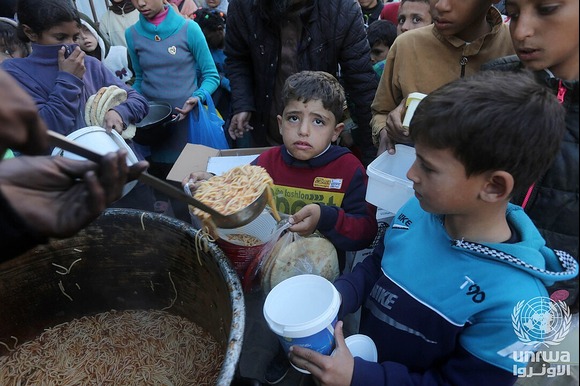
By Ashraf Amra - United Nations Relief-Wikipedia
Gaza Strip – June 15, 2025 – At least 79 Palestinians have been killed across the Gaza Strip following Israeli air and ground strikes, including numerous casualties near an aid distribution site operated by the United States- and Israeli-supported Gaza Humanitarian Foundation (GHF), according to health officials in the enclave. The latest deaths occurred as many Palestinians, driven by acute hunger, gathered in desperation to seek food aid.
Doctors at al-Awda and Al-Aqsa hospitals in central Gaza reported that at least 15 of the dead were struck while attempting to access aid at the GHF distribution point near the so-called Netzarim Corridor on Saturday. The remaining victims, they said, were killed in various other strikes across the besieged territory. The Gaza Ministry of Health said that since the GHF began its operations last month, at least 274 people have died and more than 2,000 have been wounded near aid distribution areas.
The GHF announced it was not operational on Saturday, yet witnesses said large crowds still gathered near its aid points, with many people left with no choice but to risk their lives due to the extreme scarcity of food. Israel’s continued military offensive and a punishing blockade have pushed Gaza to the edge of famine over the past 15 weeks.
Al Jazeera’s correspondent Tareq Abu Azzoum, reporting from Deir el-Balah, noted that many Palestinians have begun referring to the aid distribution sites as “execution sites,” in light of the repeated deadly attacks near them. “But the people of Gaza have exhausted all options,” he said, “and they’re being forced to journey to these dangerous spaces in search of aid.”
Israel imposed a total humanitarian blockade on Gaza on March 2, sealing off food, medicine, fuel, and all essential supplies for 11 weeks. Under increasing global pressure, it began allowing limited shipments of aid in late May. However, aid agencies argue that the quantities allowed remain grossly inadequate for the scale of humanitarian needs.
Neither the Israeli military nor the Gaza Humanitarian Foundation have released statements addressing Saturday’s fatal incidents.
The GHF, a US- and Israeli-backed charity headed by evangelical leader Johnnie Moore — a former advisor to Donald Trump during his 2016 presidential campaign — launched its operations in Gaza on May 27. The foundation is using a controversial new model for aid distribution, which the United Nations has criticized as lacking neutrality and impartiality.
Israel and the US have claimed, without providing evidence, that Hamas has been diverting aid from the UN-led distribution system to fund its military operations. They say the GHF model is meant to replace the UN system entirely. Meanwhile, Israel has admitted to arming criminal groups in Gaza in an effort to destabilize Hamas. These groups have reportedly looted aid convoys, contributing to the breakdown of humanitarian delivery systems.
UN officials dispute Israel’s accusations against Hamas, insisting there is no credible evidence of large-scale aid diversion. They argue that the new aid delivery model worsens conditions by allowing Israel to control access to humanitarian assistance and forcing Palestinians to cross long distances through active conflict zones, often after having already been displaced multiple times.
Later on Saturday, the Israeli military issued new evacuation orders to residents in the southern Gaza city of Khan Younis and surrounding towns, including Abasan and Bani Suheila, instructing them to flee west toward so-called humanitarian zones. The military stated it would intensify operations against “terror organizations” in the area.
According to the UN Office for the Coordination of Humanitarian Affairs (OCHA), more than 80 percent of the Gaza Strip now lies within areas designated by Israel as militarized zones, evacuation zones, or both. The agency estimates that approximately 665,000 people have been displaced again since Israel broke a ceasefire in February, triggering renewed mass displacement and worsening the humanitarian crisis.
Health authorities in Gaza report that Israel’s ongoing offensive has killed more than 55,290 Palestinians, the majority of them civilians. The campaign has razed large swathes of Gaza’s densely populated landscape, leaving most of the territory’s over two million residents homeless or internally displaced, while widespread malnutrition and disease continue to take a growing toll.
Despite mediation efforts by the United States, Egypt, and Qatar, attempts to reinstate a ceasefire have stalled. Neither Israel nor Hamas has agreed to the opposing party’s conditions. Hamas continues to demand a permanent ceasefire and a guarantee that Israel will not resume hostilities — terms Israel has so far rejected.
With no end in sight, the death toll and humanitarian suffering in Gaza continue to mount, while access to basic necessities remains elusive for much of the population.




